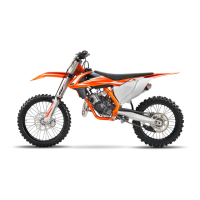15 TUNING THE ENGINE 83
15.4 Carburetor – idle
402799-10
The idle setting of the carburetor has a big influence on the starting behavior, stable
idling, and the response to throttle opening. This means that an engine with a correctly
set idle speed is easier to start than if the idle speed is set wrongly.
Info
The carburetor and its components are subject to increased wear caused by
engine vibration. Wear can result in malfunctioning.
The factory setting for the carburetor is set for the following values.
Height above sea level 301… 750 m (988… 2,461 ft)
Ambient temperature 16… 24 °C (61… 75 °F)
Super unleaded (98 octane) mixed with 2-stroke engine oil (1:40) ( p. 104)
The idle speed is adjusted with adjusting screw
1
.
The idle mixture is adjusted using the idle air adjusting screw
2
.
15.5 Carburetor – adjusting the idle speed
402799-11
–
Screw in idle air adjusting screw
1
all the way and turn it to the specified basic
position.
Info
The basic adjustment is shown under the respective model.
– Run the engine until warm.
Guideline
Warm-up time ≥ 5 min
Danger
Danger of poisoning Exhaust gases are toxic and inhaling them may result
in unconsciousness and death.
– Always make sure there is sufficient ventilation when running the
engine.
– Use an effective exhaust extraction system when starting or running the
engine in an enclosed space.
–
Adjust the idle speed with adjusting screw
2
.
Guideline
Choke function deactivated – The choke lever is pushed in to the stop. ( p. 14)
Idle speed 1,400… 1,500 rpm
–
Turn idle air adjusting screw
1
slowly in a clockwise direction until the idle speed
begins to fall.
– Note the position and turn the idle air adjusting screw slowly counterclockwise until
the idle speed again begins to fall.
– Adjust to the point between these two positions with the highest idle speed.
Info
If there is a big engine speed rise, reduce the idle speed to a normal level
and repeat the above steps.
If the procedure described here does not lead to satisfactory results, the
cause may be a wrongly dimensioned idling jet.
If you can turn the idle air adjusting screw to the end without any change of
engine speed, mount a smaller idling jet.
After changing the jet, start from the beginning with the adjusting steps.
Following extreme air temperature or altitude changes, adjust the idle speed
again.

